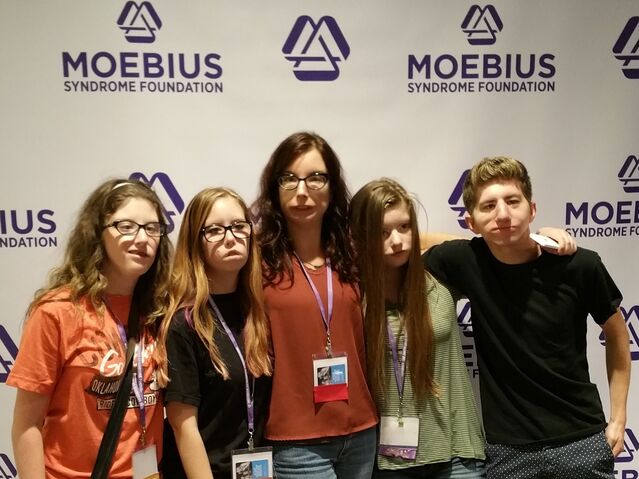Bias
7 Things to Understand on Moebius Syndrome Awareness Day
Psychologist with Moebius syndrome explains the value of expressive diversity.
Posted January 18, 2021 Reviewed by Ekua Hagan
Moebius Syndrome Awareness Day is January 24. I'm a psychology professor who has and studies Moebius syndrome. Here are seven reasons why people with Moebius syndrome like myself seek understanding on many levels.

1. Moebius syndrome involves facial paralysis and lateral eye movement paralysis.
It’s a rare congenital neurological disorder involving facial paralysis and lateral eye movement paralysis. It's caused by underdevelopment of the sixth and seventh cranial nerves in the brainstem, which govern lateral eye gaze and facial expression, respectively. No genetic or hereditary cause for Moebius has been identified. One theory is it might be caused by a brief disruption in blood flow to the embryo during early development (Briegel, 2006). Moebius has diverse effects. Some people have additional symptoms such as limb abnormalities and crossed eyes. Although the physical symptoms of Moebius may be challenging to navigate at first, once parents and people with Moebius syndrome develop expertise, many feel the remaining challenges are social in nature (Bogart & Hemmesch, 2016).
2. The #1 request from the Moebius syndrome community for is greater public understanding.
Moebius is a very visible but unrecognizable disability, meaning that strangers may immediately notice that the person looks different, but can’t figure out why (Bogart & Tickle-Degen, 2015). They make erroneous assumptions about the cause, nature, and accommodations needed. People with Moebius syndrome hear about all sorts of “interpretations” of their appearance. Strangers ask them if they had just gotten a Novocain shot, if they were having a stroke, or if the condition was contagious, deadly, or painful (Bogart, 2015).
In focus groups of people with Moebius syndrome, the most common topic is a desire for greater public awareness to reduce misunderstandings (Bogart, 2015; Bogart et al., 2012). They know firsthand that people are confused by their facial difference. Widespread awareness would reduce the need to explain Moebius and would educate others to pay attention to the alternative ways they express themselves.

3. Moebius syndrome affects communication.
People with Moebius are frequently misunderstood because facial paralysis limits expressivity (but they make up for it in body language), and it sometimes makes speech harder to understand. Because people are accustomed to receiving feedback from facial expressions, they may mistake a person with Moebius’ lack of facial expression as unfriendliness, boredom, or intellectual disability (Bogart et al., 2012).
4. People with Moebius syndrome embrace expressive diversity and you should, too.
Humans use a vast array of communication channels, including gesture, prosody (tone of voice), language, posture, proximity, style, and facial expression. My research finds that people with Moebius syndrome amp up their expression through channels other than the face, something I call alternative expression (Bogart et al., 2012). This is an effective strategy; people with facial paralysis who use a lot of alternative expression are rated more positively by strangers than those who use less (Bogart, et al., 2014). Now that we must wear masks to prevent the spread of COVID-19, people with Moebius syndrome are already skilled in communicating without facial expression; those without facial paralysis could take a cue from them about expressive diversity. Many ways of being involve expressive diversity, including disability, culture, gender, and individual differences. Being attuned to expressive diversity can make everyone more sensitive humans.
5. People with Moebius syndrome face discrimination.
People with facial differences are often avoided, stared at, feared, or bullied. Many in the Moebius community have stories about being ignored by shopkeepers or waiters, or spoken to only through a person that they are with. People with Moebius have been denied public-facing jobs or face a glass ceiling in which they are not allowed to rise to a leadership role.
6. Health care providers (including psychologists) are unfamiliar with Moebius syndrome.
The rarity of Moebius means that most providers aren’t familiar with it, leading to diagnostic delays and inadequate support. It takes people with rare diseases 7-9 years on average to receive an accurate diagnosis. Healthcare providers should understand how to recognize Moebius syndrome, and how to research what they do not know with humility.
7. Research shows that information in this post reduces bias toward people with Moebius.
I conducted an experiment testing whether awareness helps people form more positive impressions of those with Moebius syndrome (Bogart & Tickle-Degnen, 2015). Some participants were assigned to an “awareness condition,” in which they read information like that in this post], and some were assigned to a control condition in which they were not given any information about facial paralysis. Next, all participants watched brief videos of people with facial paralysis. The participants in the awareness condition rated people with facial paralysis more positively than those in the control group. Knowledge is powerful!
Share this post to promote public understanding about Moebius syndrome. Understand that someone with an unusual or unexpressive face may have facial paralysis. Understand that facial differences are not scary. Understand expressive diversity.
References
Bogart, K. R. (2015). “People are all about appearances”: A focus group of teenagers with Moebius syndrome. Journal of Health Psychology, 20, 1579-1588. doi: 10.1177/135910531351727
Bogart, K. R., & Hemmesch, A. R. (2016). Benefits of support conferences for parents of and people with Moebius syndrome. Stigma and Health, 1(2), 109.
Bogart, K. R., & Tickle-Degnen, L. (2015). Looking beyond the face: A training to improve perceivers’ impressions of people with facial paralysis. Patient Education and Counseling, 98, 251-256. doi: 10.1016/j.pec.2014.09.01
Bogart, K. R., Tickle-Degnen, L., & Ambady, N. (2012). Compensatory expressive behavior for facial paralysis: Adaptation to congenital or acquired disability. Rehabilitation Psychology, 57(1), 43-51. doi: 10.1037/a002690
Bogart, K. R., Tickle-Degnen, L., & Ambady, N. (2014). Communicating without the face: Holistic perception of emotions of people with facial paralysis. Basic and Applied Social Psychology, 36 (4), 309-320. doi: 10.1080/01973533.2014.91797
Bogart, K. R., Tickle-Degnen, L., & Joffe, M. (2012). Social interaction experiences of adults with Moebius syndrome: A focus group. Journal of Health Psychology, 17(8), 1212-1222. doi: 10.1177/135910531143249
Briegel, W. (2006). Neuropsychiatric findings of Moebius sequence–a review. Clinical Genetics, 70(2), 91-97.


